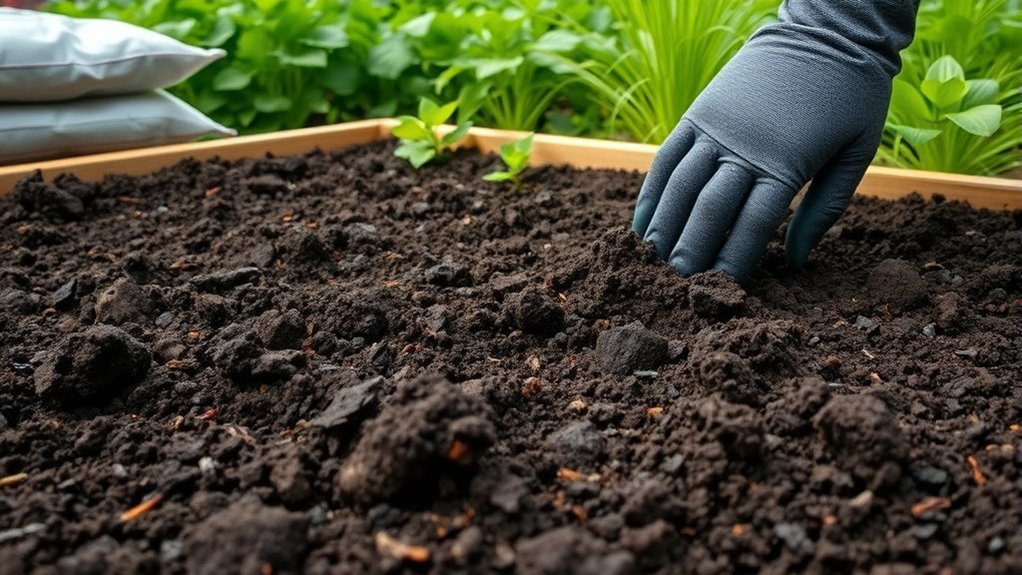To avoid common pitfalls with raised bed soil mixes, start with quality, uncontaminated materials and guarantee proper drainage by adding coarse substances like gravel or perlite. don’t overload with fertilizers; base amendments on soil tests to maintain pH and nutrient balance. Plan for enough soil depth, mix components thoroughly, and incorporate organic matter regularly to improve structure and fertility. If you keep these tips in mind, you’ll create a healthy environment for vibrant plants and strong roots.
Key Takeaways
- Use clean, uncontaminated soil and source from reputable suppliers to prevent pests and soil-borne diseases.
- Incorporate coarse materials like gravel or perlite to ensure proper drainage and avoid waterlogging.
- Regularly test and adjust soil pH and nutrients based on soil analysis for optimal plant health.
- Ensure sufficient soil depth (12-18 inches) tailored to plant root needs, avoiding overly shallow or deep beds.
- Apply fertilizers and amendments sparingly, based on soil tests, to prevent nutrient imbalances and salt buildup.
Choosing the Wrong Base Materials
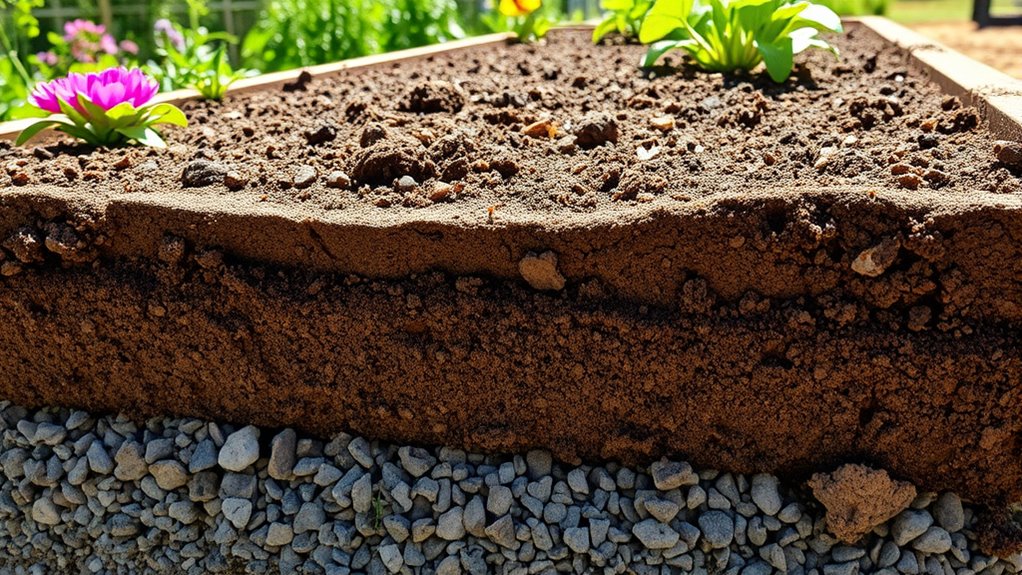
Choosing the wrong base materials can substantially compromise the health of your raised bed garden. To avoid this, start with soil testing to determine its current nutrient levels and pH balance. Knowing your soil’s condition helps you select appropriate organic amendments that improve fertility and structure. Avoid using substandard or contaminated materials like construction debris, which can introduce toxins or pests. Instead, opt for a mix of high-quality compost, well-aged manure, and native soil suited to your plants’ needs. Proper base materials promote good drainage, aeration, and nutrient retention. Regular soil testing also guides you in adjusting your organic amendments over time, ensuring your raised bed remains healthy and productive. Additionally, using energy-efficient soil mixes can help maintain consistent temperatures and moisture levels, supporting optimal plant growth. Remember, foundational soil quality is key to thriving plants.
Overloading With Fertilizers and Amendments
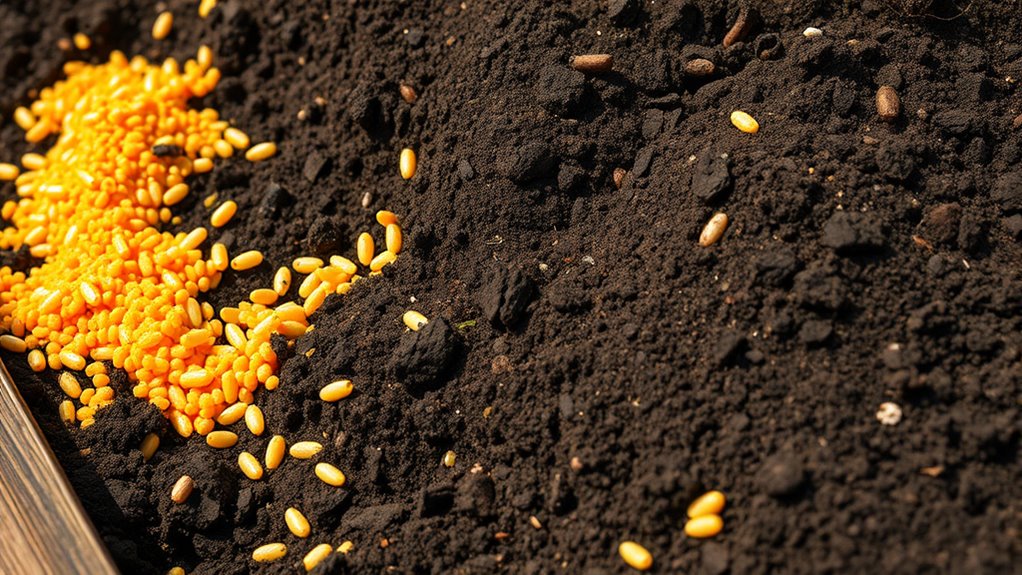
Adding too many fertilizers and amendments can harm your plants and disrupt the soil balance. Overloading might lead to nutrient buildup that causes deficiencies or toxicities. Plus, you’ll end up wasting money on unnecessary products that don’t benefit your garden. To ensure a healthy soil environment, understanding the proper soil management practices is essential.
Excess Nutrients Harm Plants
While fertilizers and soil amendments are essential for healthy plant growth, overdoing it can backfire. Excess nutrients can lead to nutrient toxicity, which stresses plants and hampers their development. When you overload your raised bed with fertilizers, roots may struggle to absorb what they need, and harmful salts can accumulate, damaging root systems. This imbalance can stunt growth, cause leaf burn, or even kill plants. Additionally, nutrient toxicity disrupts plant health by interfering with nutrient uptake and creating an environment hostile to beneficial microbes. To keep plants thriving, apply fertilizers and amendments sparingly and follow recommended dosages. Regularly monitor your plants for signs of overfeeding, and remember that more isn’t always better—balance is key to healthy, productive raised beds. Proper sprayer maintenance can also help prevent over-application and ensure consistent nutrient delivery.
Soil Imbalance Risks
Overloading your raised bed with fertilizers and amendments can create significant soil imbalances that threaten plant health. When you add too much, you risk disrupting nutrient ratios and harming beneficial microbes. To prevent this, perform regular soil testing to monitor nutrient levels and avoid overapplication. Incorporate composting techniques that build balanced organic matter, reducing the need for excessive external inputs. Be cautious with amendments like lime or sulfur, as they can skew pH if used improperly. Overloading can lead to nutrient lockout, root damage, and poor plant development. Staying vigilant and applying fertilizers sparingly ensures your soil remains healthy and productive. Additionally, understanding soil testing methods can help you make more informed fertilization decisions. Remember, moderation and proper testing are key to maintaining a balanced, thriving raised bed garden.
Costly Fertilizer Waste
Excessive use of fertilizers and amendments often leads to significant waste, costing you more money without delivering proportional benefits. Instead of blindly adding nutrients, perform soil testing to identify what your raised bed truly needs. Overloading with fertilizers can cause nutrient runoff, pollution, and root damage, while organic amendments can improve soil health without excess. When you understand your soil’s deficiencies, you can apply the right amount of amendments, avoiding waste and saving money. Applying too much fertilizer or amendments doesn’t make plants grow better; it just creates a surplus that goes to waste. Being precise with soil testing and using organic amendments responsibly ensures your plants receive what they need, reducing costs and promoting healthier growth. Additionally, understanding soil composition helps you create a balanced soil environment that supports long-term plant vitality.
Ignoring Drainage Needs
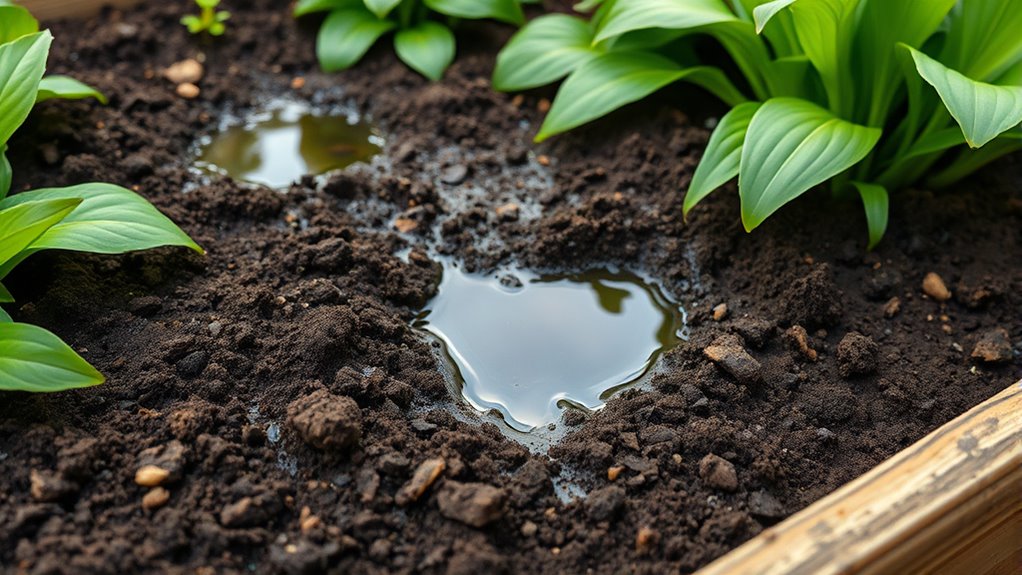
Ignoring drainage needs can lead to serious problems in your raised bed. Poor drainage causes water to pool, suffocating roots and reducing soil aeration. This can result in root rot and stunted plant growth. To prevent this, make certain your soil mix promotes proper drainage and allows for effective pH adjustment. Without it, plants struggle to absorb nutrients, and soil can become compacted over time. Adjusting pH levels and maintaining good drainage help keep your soil healthy and aerated, supporting strong plant roots.
Consider these tips:
- Incorporate coarse materials like gravel or perlite to improve drainage
- Regularly check and adjust soil pH for ideal plant health
- Avoid compacting the soil when planting or watering
- Use raised beds with proper slope for runoff and aeration
Using Poor-Quality Soil Components
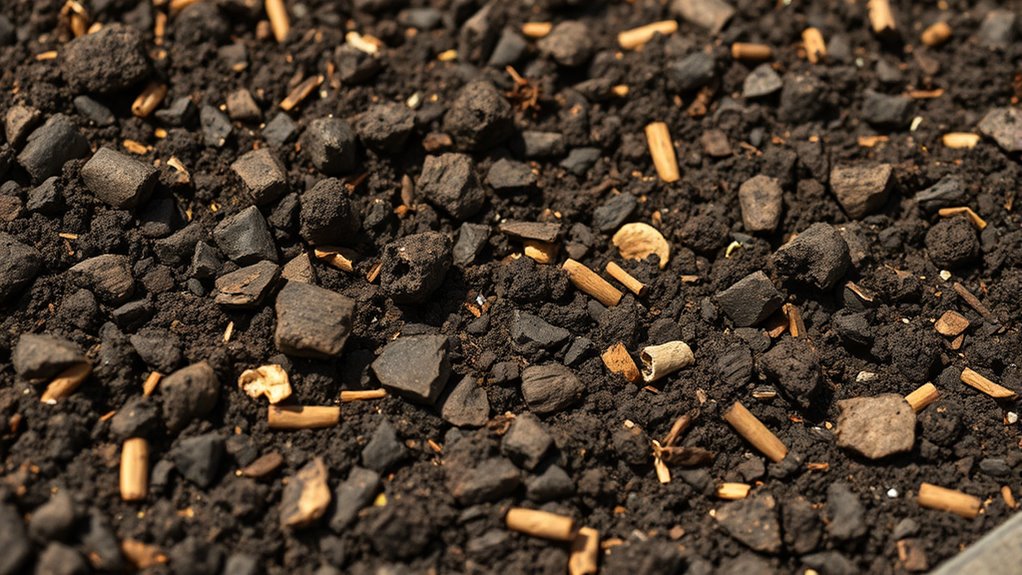
Using poor-quality soil components can sabotage your raised bed’s success. You might end up with low nutrients, contaminants, or pests that threaten your plants’ health. Additionally, these materials can cause poor drainage and compaction, making it harder for roots to grow properly.
Low Nutrient Content
When you choose poor-quality soil components for your raised bed, you risk creating a nutrient-deficient environment that hampers plant growth. Low nutrient content can result from soil that lacks essential minerals or has improper soil acidity, making nutrients unavailable to your plants. Without adequate organic amendments, the soil won’t supply enough nutrients or improve soil structure. Over time, plants may show stunted growth, yellowing leaves, or poor yields. To avoid this, select soil mixes rich in organic matter and ensure proper soil pH. Adding compost or aged manure boosts nutrients naturally. Regular testing helps monitor soil health. Remember, healthy plants depend on nutrient-rich soil that’s balanced in acidity and enriched with organic amendments. Incorporating top-rated soil mixes designed for gardening can also help ensure your soil has the right nutrients from the start.
Contaminants and Pests
Are you aware of the risks posed by poor-quality soil components in your raised beds? Using contaminated soil can introduce soil contamination and pests, leading to plant diseases and reduced yields. Poor-quality soil may harbor pest infestation sources or harmful pathogens, which can quickly spread. Always inspect soil sources carefully before adding them to your beds. Ensuring proper soil quality can help prevent these issues and promote healthy plant growth.
| Risk | Solution |
|---|---|
| Soil contamination | Use tested, reputable soil mixes |
| Pest infestation | Avoid using compost or soil from unknown sources |
Choosing quality soil components minimizes these risks, protecting your plants and ensuring a healthy garden. Poor-quality, contaminated soil can undermine your efforts, so always prioritize safe, clean soil to keep pests and pathogens at bay.
Poor Drainage and Compaction
Contaminated or poor-quality soil components can also cause issues like poor drainage and compaction, which hinder plant growth. When soil compacts, water retention becomes uneven, and soil aeration decreases, preventing roots from accessing oxygen. This can lead to root rot and stunted growth. Using low-grade soil mixes may result in water pooling, making it difficult for plants to thrive. To avoid these problems, guarantee your soil has proper structure and drainage. Additionally, understanding fan culture can help gardeners appreciate the importance of maintaining healthy, supportive environments for their plants, much like fostering positive community interactions.
- Use coarse, organic materials like compost and aged manure for better aeration
- Avoid overly dense soils that prevent water movement
- Incorporate perlite or sand to improve drainage and reduce compaction
- Regularly loosen soil to maintain ideal water retention and aeration
Neglecting Soil Ph and Nutrient Balance

Neglecting to monitor and adjust soil pH and nutrient levels can undermine the success of your raised bed garden. If the soil pH is too high or too low, nutrients become less available to plants, stunting growth or causing deficiencies. Regular testing helps you identify imbalances early. Maintaining proper nutrient balance ensures your plants receive essential elements like nitrogen, phosphorus, and potassium in appropriate amounts. Over time, nutrients can become depleted or imbalanced, especially if you don’t amend the soil. Without these adjustments, your plants may struggle to thrive, leading to poor yields and increased vulnerability to pests and diseases. Stay proactive by testing soil pH and nutrients periodically, then amend your soil with lime, sulfur, or organic fertilizers as needed.
Not Planning for Proper Soil Depth
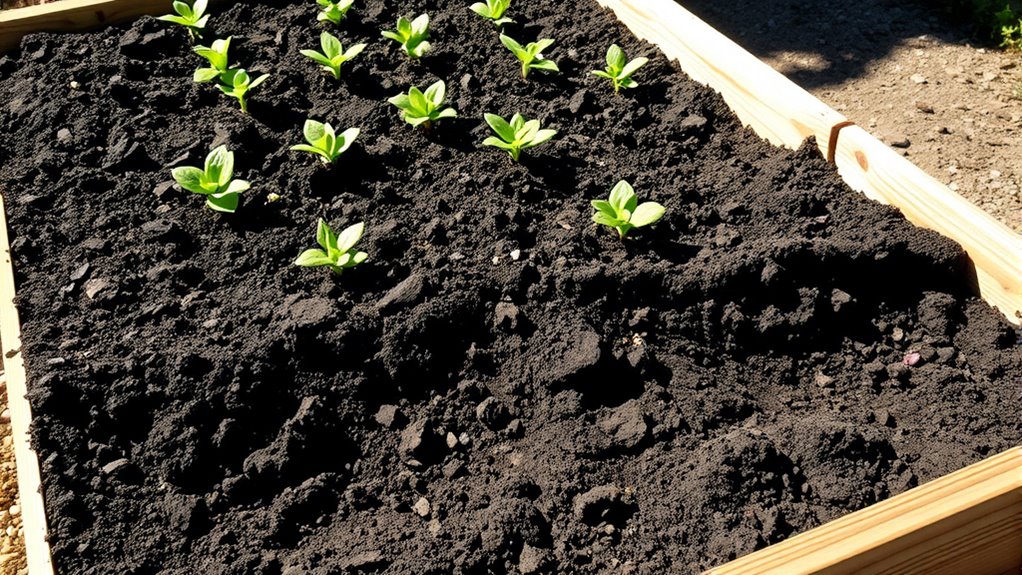
Proper soil depth is fundamental to the health and productivity of your raised bed garden. If the soil isn’t deep enough, plant roots won’t have room to grow, limiting nutrient uptake and stability. Conversely, too much depth can be inefficient and unnecessary. To avoid this pitfall, consider the mature size of your plants and their root systems. Hydrogen fuel cells generate zero harmful emissions, making them a clean energy alternative that can also be considered in sustainable gardening practices. Ensure at least 12-18 inches of soil for vegetables and deep-rooted plants. Check the bed’s height before filling to accommodate root growth. Use a level to maintain consistent soil depth across the bed. Remember that shallow beds restrict root expansion, stunting plant growth. Planning for proper soil depth helps your plants develop strong roots, leading to healthier, more productive harvests.
Failing to Mix Components Thoroughly
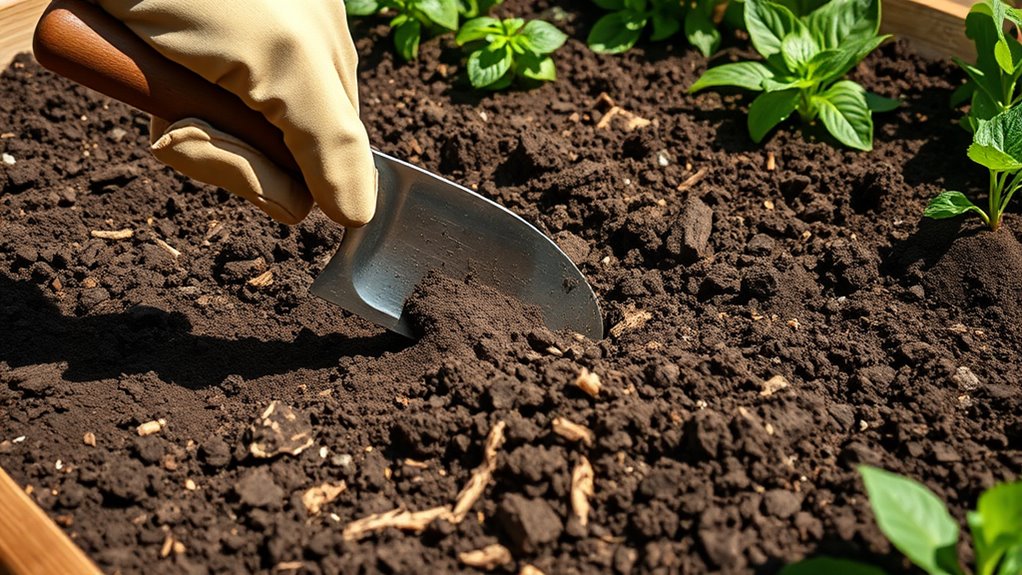
Failing to mix soil components thoroughly can lead to uneven nutrient distribution and poor plant growth. When the ingredients aren’t combined well, some areas may become compacted, reducing soil aeration and hindering root development. Poor mixing can also cause inconsistent moisture retention, with some spots holding too much water while others dry out quickly. This imbalance stresses plants and can lead to disease or stunted growth. To avoid these issues, thoroughly blend your soil mix until it’s uniform in texture and composition. Proper mixing ensures that nutrients, moisture, and air are evenly distributed throughout the raised bed, creating an ideal environment for healthy roots and vigorous plants. Incorporating AI-driven tools can help optimize soil blends by analyzing component ratios and ensuring consistency. Skipping this step compromises the effectiveness of your soil and your gardening success.
Overlooking the Importance of Organic Matter
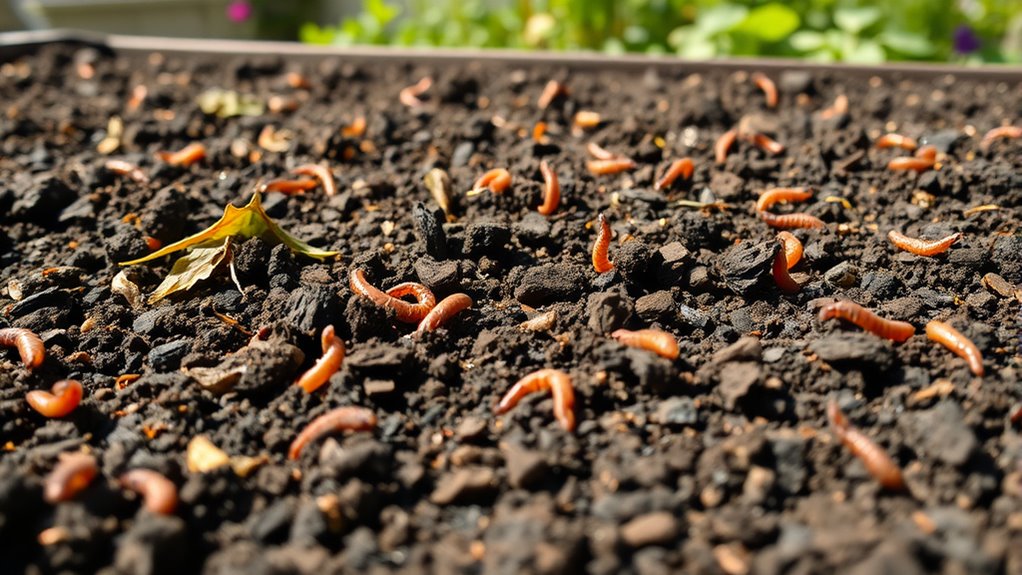
After thoroughly mixing your soil components, it’s easy to overlook the essential role organic matter plays in creating a healthy growing environment. Organic matter improves soil structure, retains moisture, and supplies nutrients over time. Without enough organic composting, your plants may struggle to thrive. To boost soil vibrancy, regularly add compost to your raised beds, ensuring continuous nutrient availability. Incorporate organic composting methods to maintain soil health and prevent nutrient depletion. Failing to include sufficient organic matter can lead to poor drainage, compacted soil, and reduced plant growth. Remember, healthy soil starts with a good balance of organic material that supports beneficial microorganisms and fosters robust plants. Dog breeds can also influence the type of organic matter that benefits your soil, as some breeds shed more than others, affecting compost quality.
Forgetting to Regularly Refresh or Replace Soil
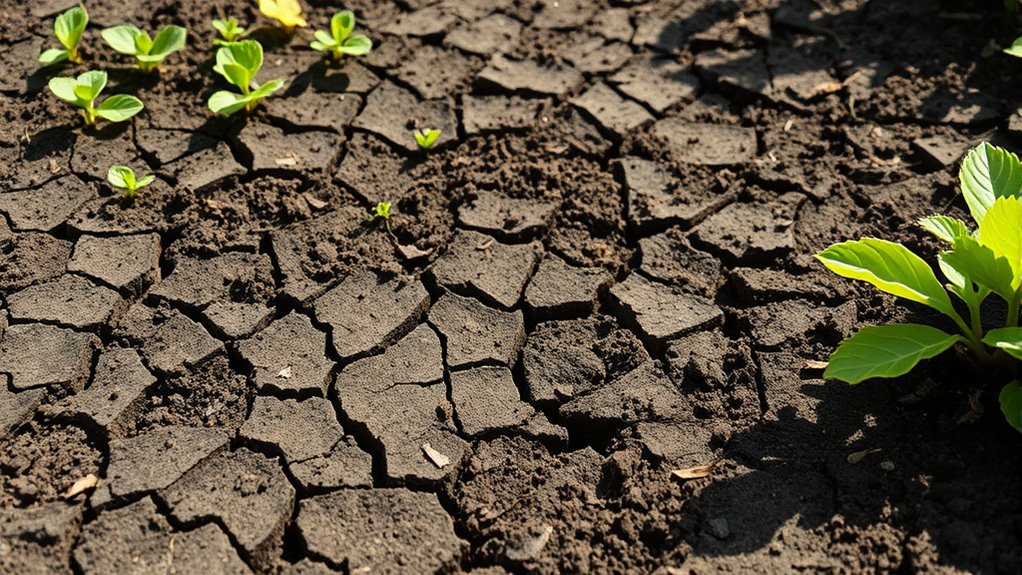
Neglecting to regularly refresh or replace your soil can lead to depleted nutrients and reduced plant growth over time. To avoid this, incorporate composting techniques into your routine, adding fresh organic matter to restore soil vitality. Regular soil testing helps you monitor nutrient levels and pH balance, guiding you on when it’s time for a refresh. Over time, beneficial microbes decline, and harmful pathogens can build up, hindering plant health. By periodically replacing or amending your soil, you guarantee it remains nutrient-rich and productive. Keep an eye on your plants’ performance, and don’t hesitate to refresh your soil when needed. Proper maintenance maintains soil fertility and promotes healthy, vigorous growth in your raised beds.
Frequently Asked Questions
How Can I Test My Soil Mix’s Ph and Nutrient Levels?
To test your soil mix’s pH and nutrient levels, you should start with a soil testing kit, available at garden centers or online. Follow the instructions carefully to collect samples and perform the test. For detailed nutrient analysis, consider sending samples to a local extension service or lab. Regular testing helps you monitor pH and nutrient levels, ensuring your plants get the right balance for healthy growth.
What Are Signs of Poor Drainage in My Raised Bed?
You’ll notice poor drainage if your raised bed waterlogs quickly after rain or watering—more than 24 hours to drain is a red flag. Remarkably, over 60% of gardeners struggle with this issue due to improper soil amendment methods. To improve drainage, incorporate composting techniques and amend your soil with coarse materials like sand or organic matter. This helps prevent water buildup, keeps roots healthy, and boosts plant growth.
How Often Should I Replace or Refresh My Soil?
You should refresh your soil in container gardening every 1 to 2 years to maintain its health. Incorporate soil amendments like compost or organic matter during this process to boost nutrients and improve drainage. Regularly mixing in fresh soil helps prevent compaction and nutrient depletion, ensuring your plants thrive. Keep an eye on plant growth; if you notice poor performance, it’s a good indication it’s time to update your soil mix.
Which Organic Materials Best Improve Soil Fertility?
You should add organic materials like compost tea and worm castings to boost your soil fertility. Compost tea supplies essential nutrients and beneficial microbes, while worm castings enrich the soil with organic matter and slow-release nutrients. Mix these into your raised bed soil regularly to enhance plant growth, improve soil structure, and promote healthy roots. Using these natural amendments creates a vibrant, fertile environment for your garden to thrive.
How Do I Ensure My Soil Mix Is Deep Enough for Plants?
Did you know that most plants need at least 12 inches of soil for healthy growth? To make certain your soil mix is deep enough, measure the soil depth accurately using a soil depth measurement tool. Perform a root penetration assessment by gently inspecting how far roots extend downward. This helps you determine if the soil depth supports your plants’ needs, promoting strong roots and bountiful growth.
Conclusion
By choosing the right base materials, avoiding over-fertilization, ensuring proper drainage, selecting quality soil components, balancing pH and nutrients, planning for adequate depth, mixing thoroughly, adding organic matter, and revitalizing regularly, you’ll create a thriving raised bed garden. Stay mindful of these pitfalls, stay consistent in your care, and stay committed to quality. With attention to detail and proactive steps, you’ll cultivate healthy plants, bountiful harvests, and a garden you can truly be proud of.
